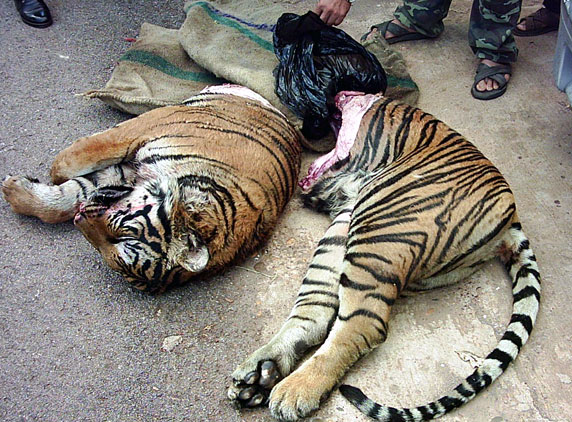
"Panthera tigris tigris" is the other name for the Bengal Tiger which are found in the Sundarbans most densely marshy mangrove forest in the world on the salt water. A type of plant know as "halophyte" that grows in waters of high salinity, coming into contact with saline water through its roots or by salt spray. The Sunderbans happens to be a UNESCO World Heritage Site covering parts of Bangladesh and Indian state of West Bengal in which Two-third of the Sundarbans is in Bangladesh while rest one-third is in West Bengal, India. This place is know to be the largest reserves for the Bengal Tiger.
"Sundarban" could be literally translated as "beautiful forest" in the Bengali language have been said to be named after the Sundari trees that are found in Sundarbans in large numbers.
A typical Bengal Tiger is worn by a coat which is yellow to light orange, with stripes ranging from dark brown to black; the belly and the interior parts of the limbs are white, and the tail is orange with black rings. Male Bengal tigers have an average total length of 270 to 310 cm (110 to 120 in) including the tail while females measure 240 to 265 cm (94 to 104 in) on average. The tail is typically 85 to 110 cm (33 to 43 in) long, and on average, tigers are 90 to 110 cm (35 to 43 in) in height at the shoulders. The average weight of males is 221.2 kg (488 lb), while that of females is 139.7 kg (308 lb).
Over the past century tiger numbers have fallen dramatically, with a decreasing population trend. None of the Tiger Conservation Landscapes within the Bengal tiger range is large enough to support an effective population size of 250 individuals. Habitat losses and the extremely large-scale incidences of poaching are serious threats to the species' survival. Poaching is a crime while people kill the tigers with poisoning, steel traps, firearms and electrocution. It is found that Tiger poaching occurs in all areas where large number of tigers have been recorded. Poaching is particularly prevalent in the States of Madhya Pradesh, Uttar Pradesh, West Bengal, Bihar, Maharashtra, Andhra Pradesh, Karnataka, Kerala, Rajasthan, Uttarakhand and Assam. This has resulted in having a decreasing trend with the total population estimated at fewer than 2,500 individuals. Therefore, its high time now that we realize and support the trend of Tiger Conservation Project run by various national and international organizations like WWF, WPSI India who are committed in saving these species for a bright tomorrow.

The poaching of any species in general would be under the Wild Life (Protection) Act, 1972, attracts a maximum sentence of three years imprisonment or a fine which may extend to Rs. 25,000 or both and in case of offence committed within a sanctuary or natural park, attracts a mandatory prison term of three years, which may extend to seven years. There is also a mandatory fine of at least Rs. 10,000. According to WPSI, despite these penalties, the laws are difficult to enforce. WPSI's wildlife crime database has records of over 900 tiger-related court cases, but only a few of these have resulted in convictions and most are still pending in the courts. To date, WPSI has records of only 61 people that have been convicted for killing a tiger or trading in tiger parts.
There is a serious need for us to realize the evil act going on against this species and take an oath to save the tigers.
Remember, they also deserve to live!

(AW:Samrat Biswas)


























